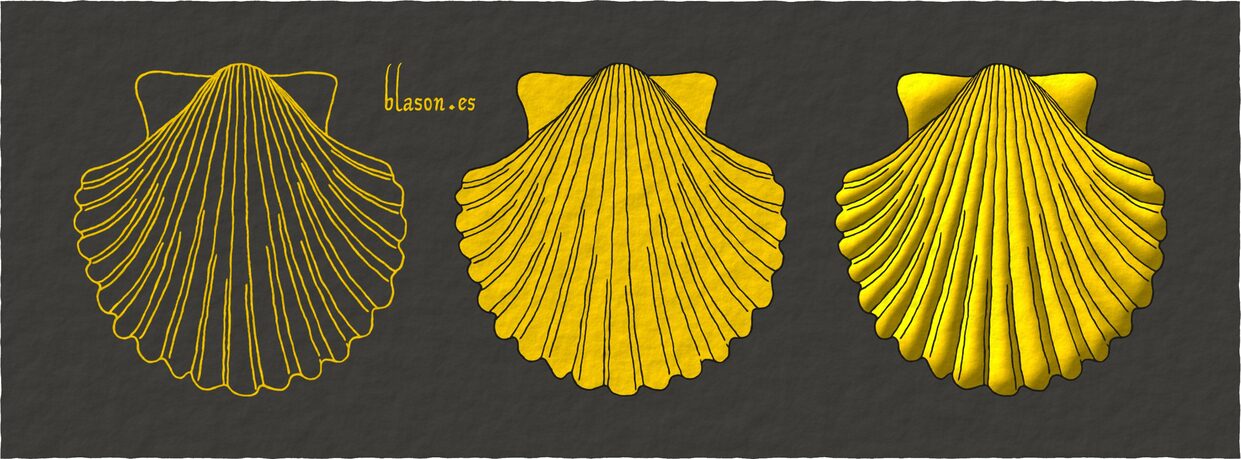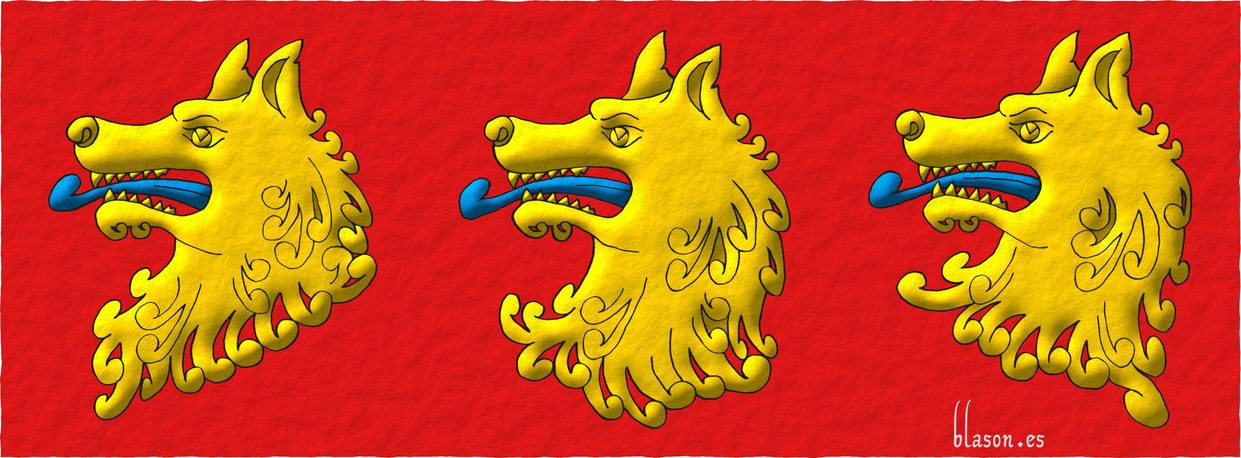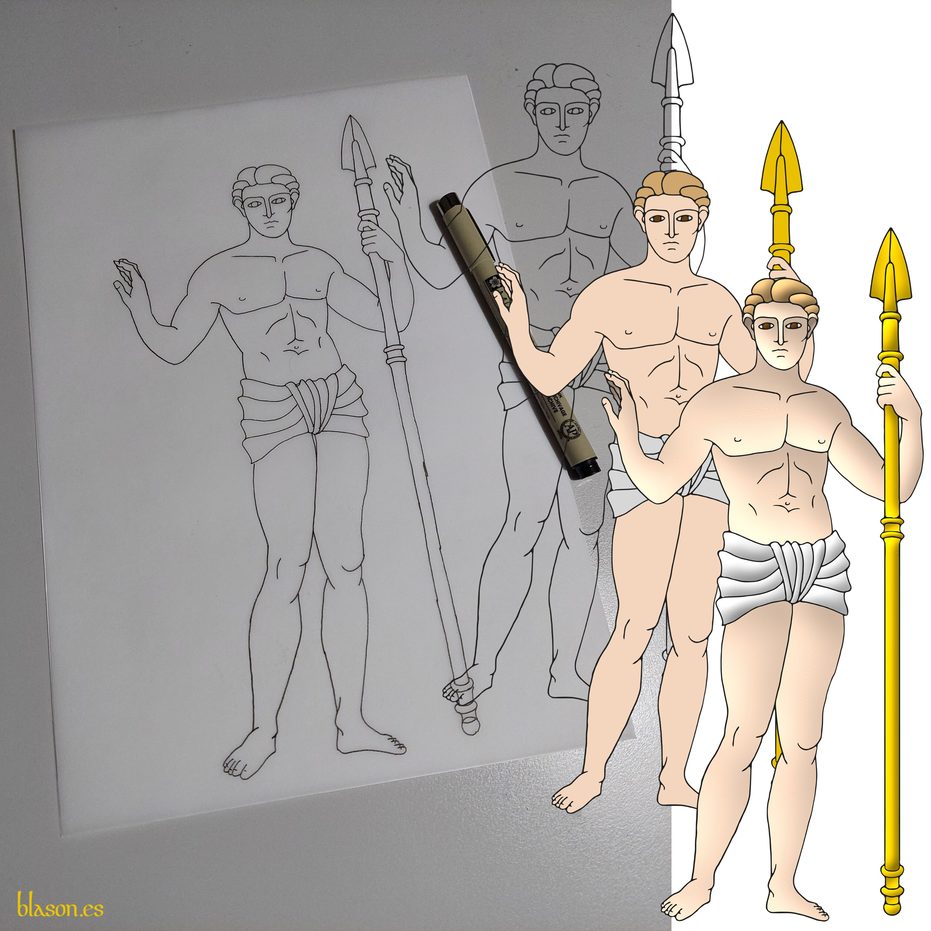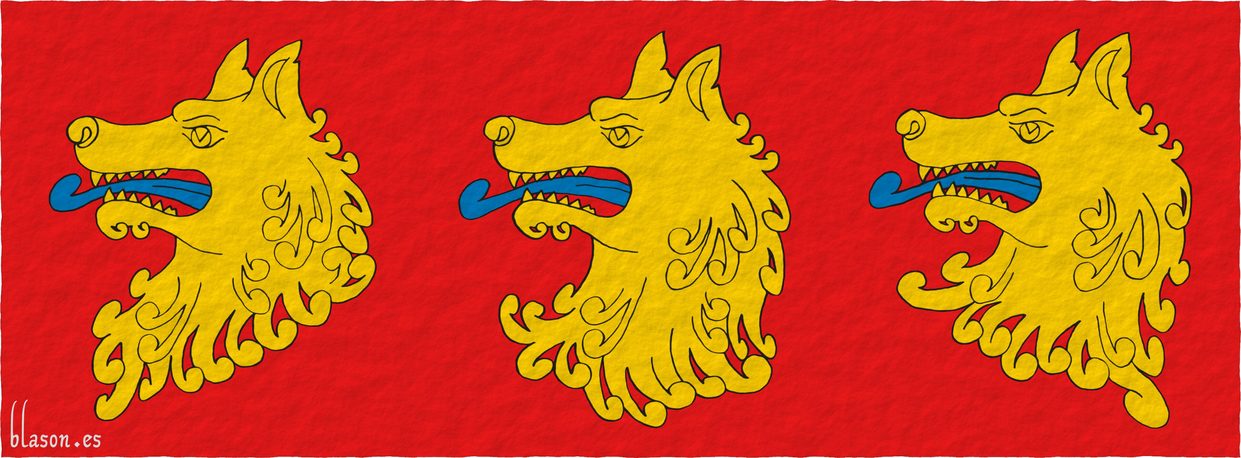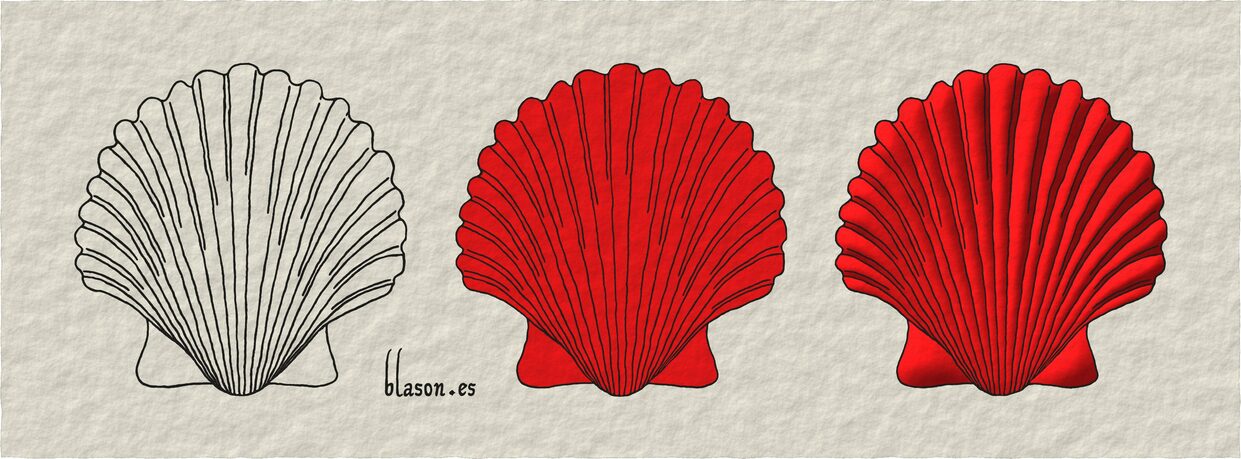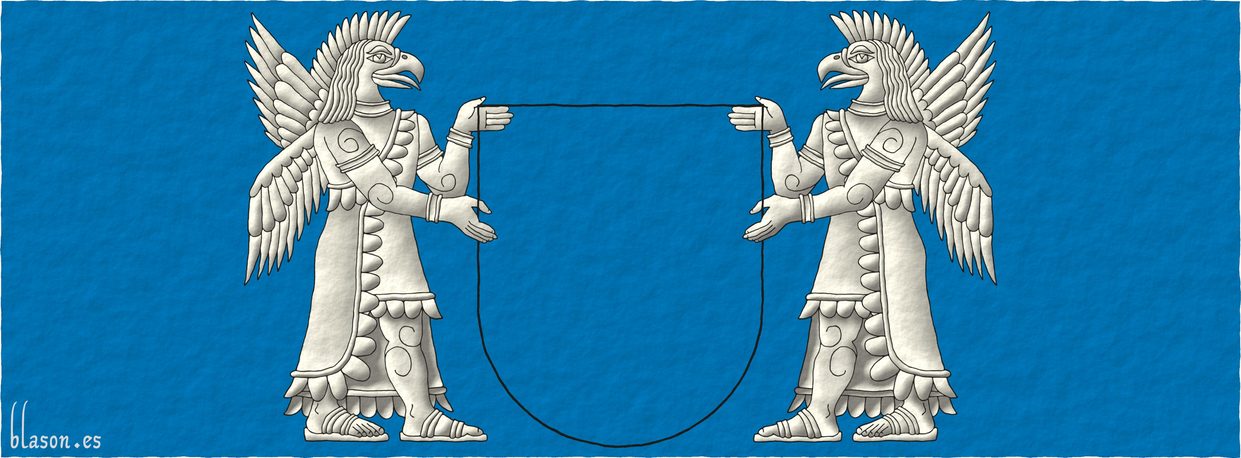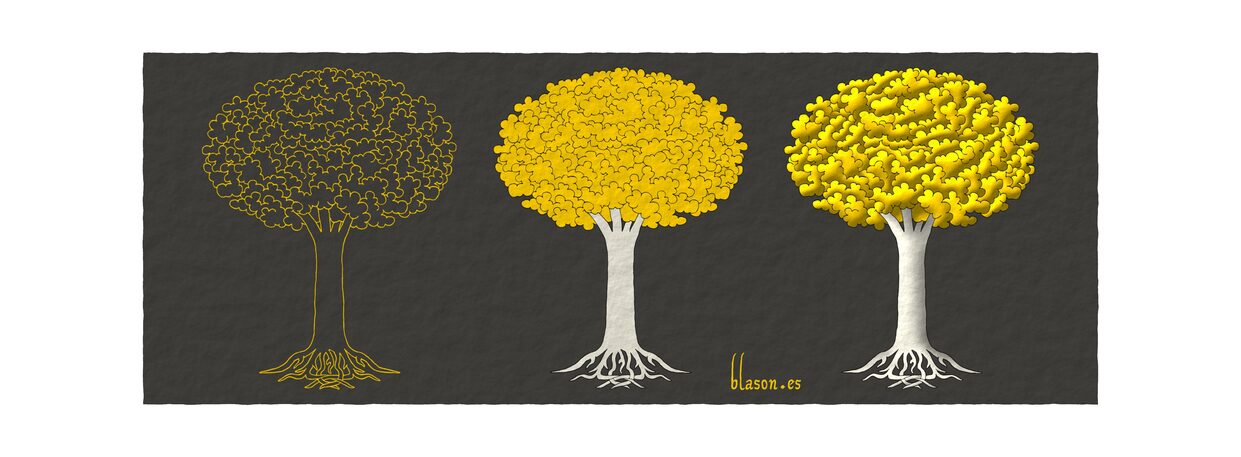Glossary


Fur
[ Ermine ], [ Vair ] and [ Or papelonny Gules ].
[ Escudo de armiños ], [ Escudo de veros ] y [ Escudo de oro papelonado de gules ].
Three coats of arms with a semicircular base and a freehand finish.
fur, furs: A dichromatic tincture composed of one color and one metal, examples of furs include ermine, erminois, counter-ermine, pean, vair, vairy, counter-vair, counter-vairy, papelonny, and plumetty.


Supporter
Supporters: Two wolves rampant, regardant Argent, crowned their dexter arms armored, each grasping a sword Or.
Soportes: Dos lobos rampantes, contornados de plata, coronados, sus brazos diestros armados teniendo, cada uno, una espada todo de oro.
Two supporters illuminated by me in the metals Or and Argent, and outlined in Sable.
supporter, supporters: Exterior ornament of the coat of arms shown as supporting it. There may be only one, placed on one side or behind the coat of arms, but usually there are two, one on the dexter and one on the sinister, which may be symmetrical, for example, two eagles, two cannons dismounted, or two knights, or different, for example, a lady and a lion.
In Castilian heraldry, there are three terms for supporters: «soportes» for animal forms, «sostenes» for objects or plants, and «tenantes» for human figures. The following applies to «soportes», «sostenes», and «tenantes». Unlike other heraldic traditions such as English heraldry, in Castilian heraldry, there are no rules governing the use of these exterior ornaments; their use is at the armiger's discretion, without specific restrictions. They are not reserved only for nobility; their use is free for all. In the words of [Cadenas y Vicent, V. de; 1975; page 173] «there is no rule that determines the use of tenantes, soportes, and sostenes».
Categories: Supporter and Glossary.


Armed
A lion rampant Argent, armed Or.
Un león rampante de plata, armado de oro.
Emblazoned by me in 3 steps: outlined, plain metals Or and Argent, and with lights and shadows.
armed: Attribute of the claws when they are of a different tincture than the rest of the figure. It can also be used for other attack and defense elements that do not have their own attribute.
Categories: Armed and Glossary.


Axe
[ An axe Or ], [ An axe facing sinister Argent, hafted Or ], and [ An axe Argent, hafted Or ].
[ Un hacha de oro ], [ Un hacha alterada de plata, fustada de oro ] y [ Un hacha de plata, fustada de oro ].
Emblazoned by me in 3 steps: outlined, plain metals Argent and Or, and with lights and shadows.
axe, axes: Heraldic figure representing a cutting tool consisting of a metal blade with a straight or curved edge, mounted on a handle of wood or metal. Typically depicted in a palewise position, unless another attitude is specified.


Basilisk
A basilisk sajant Or.
Un basilisco sentado de oro.
Emblazoned by me in 3 steps: outlined, plain metal Or, and with lights and shadows.
basilisk, basilisks: Immaterial figure, a fabulous combination of a rooster and a serpent, winged, crested, and with a serpentine tail; it shall be depicted statant, default attitude for the rooster, unless another attitude is specified.
Categories: Basilisk and Glossary.


Caboshed
Un rencuentro de toro de sable.
A bull's head caboshed Sable.
Emblazoned by me in 3 steps: outlined, plain color, and shadow details.
caboshed: Head of an animal with horns, such as that of a stag or bull, or well-defended like that of a boar, depicted facing forward without showing the neck.
Categories: Caboshed and Glossary.


Ermine
[ Ermine ], [ Erminois ] and [ Argent erminois Azure ].
[ Escudo de armiños ], [ Escudo armiñado ] y [ Escudo de plata armiñado de azur ].
Three coats of arms with a semicircular base and a freehand finish.
ermine: A fur that represents a mantle made from the tails of those animals. Like every fur, it combines a metal, Argent, with a color, Sable. On the Argent background, small tail tips of these animals in Sable are depicted. There are multiple ways to paint these Sable tips, the most common being a shape resembling an arrow pointing toward the chief, with three small dots at its end.
In Castilian, some refer to it in the singular «armiño» but, following [Académie internationale d'héraldique; 1952], I prefer to use this heraldic term in the plural form «armiños». In English, however, it is always used in the singular: «Ermine». Remember that, like all furs, being composed of a metal and a color, it is not subject to the rule of tinctures, allowing a charge of ermine on a field of either metal or color, as well as a charge of metal or color on a field of ermine.
Categories: Ermine and Glossary.


Ermined
[ Ermine ], [ Erminois ] and [ Argent ermined Azure ].
[ Escudo de armiños ], [ Escudo armiñado ] y [ Escudo de plata armiñado de azur ].
Three coats of arms with a semicircular base and a freehand finish.
ermined: A fur that represents a variant of the fur ermine, resulting from changing one or two of its tinctures. For example, if the field remains Argent and the spots are painted Azure, it is blazoned «Argent ermined Azure». The default ermined is «Or ermined Sable», which I usually refer to simply as erminois. Another example, changing both tinctures, would be «gules ermined argent» which is closer to being a ermines.
The term «ermined» is used when they are ermine, but are neither Argent charged with Sable, that is, ermine properly so called, nor Sable charged with Argent, that is, ermines, nor any other variant with its own name, such as, «Sable ermined Or», which in English is called pean. The most common ermined fur is metal Or charged with color Sable, formerly blazoned as «ermined Or and Sable», corresponding to the English term «erminois», which I would now blazon as «Or ermined Sable», since I think it is clearer, but which I now, considering it the default combination, it has a known previous name «erminois». Likewise, when I see a blazon that says only «erminois», I therefore assume it means «Or ermined Sable». Note that the ermined fur is not just the set of Sable spots; the ermined fur is the whole thing: both the or field and the sable spots that charge it, just as the fur called ermine is the whole, both the Argent field and the Sable spots that charge it, in the same way that the coat of the animal called the ermine is pure white, Argent, with the tip of its tail black, Sable, and when several are joined together they form a white mantle, Argent, with the black spots, Sable, which are the tips of the tails of the ermines.
Categories: Ermined and Glossary.


Ermines
[ Ermines ], [ Pean ] and [ Gules ermined Argent ].
[ Escudo de contraarmiños ], [ Escudo contraarmiñado ] y [ Escudo de gules armiñado de plata ].
Three coats of arms with a semicircular base and a freehand finish.
ermines: A fur that represents a variant of the fur ermine, obtained by exchanging Argent for Sable and Sable for Argent, so that on a field of Sable appear small ermine tail-tips in Argent.
Categories: Ermines and Glossary.


Erminois
[ Ermine ], [ Erminois ] and [ Argent erminois Azure ].
[ Escudo de armiños ], [ Escudo armiñado ] y [ Escudo de plata armiñado de azur ].
Three coats of arms with a semicircular base and a freehand finish.
erminois: A fur that represents a variant of the fur «ermine», obtained by replacing Argent with Or, so that on a field of Or appear small ermine tail-tips in Sable.
Categories: Erminois and Glossary.


Escallop
An escallop Or.
Una venera de oro.
Emblazoned by me in 3 steps: outlined, plain metal Or, and with lights and shadows.
escallop, escallops: Natural figure representing the shell of the mollusk Pecten jacobaeus, also known as the pilgrim's shell, depicted with its convex side, semicircular, with ridges and the auricles towards the chief, unless another attitude is specified.
Categories: Escallop and Glossary.


Facing sinister
[ An axe Or ], [ An axe facing sinister Argent, hafted Or ], and [ An axe Argent, hafted Or ].
[ Un hacha de oro ], [ Un hacha alterada de plata, fustada de oro ] y [ Un hacha de plata, fustada de oro ].
Emblazoned by me in 3 steps: outlined, flat colors, and shadow details.
facing sinister: Attitude of a figure when it is oriented toward the sinister side, instead of the dexter, which is the usual orientation.
Categories: Facing sinister and Glossary.


Hafted
[ An axe Or ], [ An axe facing sinister Argent, hafted Or ], and [ An axe Argent, hafted Or ].
[ Un hacha de oro ], [ Un hacha alterada de plata, fustada de oro ] y [ Un hacha de plata, fustada de oro ].
Emblazoned by me in 3 steps: outlined, plain metals Or and Argent, and with lights and shadows.
hafted: Attribute of the handle of an axe, hammer, or similar weapon, when it is of a different tincture from the rest of the figure.
Categories: Hafted and Glossary.


Illuminated
...three wolves' heads erased in fess Or, langued Azure...
...tres cabezas de lobo arrancadas en faja de oro, lampasadas de azur...
The image shows three wolves' heads, emblazoned by me with lights and shadows, using the metal Or and the colour Azure.
Categories: Illuminated and Glossary.


Langued
Un león rampante de plata, lampasado de oro.
A lion rampant Argent, langued Or.
Emblazoned by me in 3 steps: outlined, flat colors, and with lights and shadows.
langued: Attribute of a heraldic figure when the tongue is of a different tincture than the rest of the body. Typically used for animals, such as lions, with tongues in a contrasting color.
Categories: Langued and Glossary.


Male figure
...supported at sinister by a man proper, wearing a loincloth Argent, holding in his sinister a spear palewise Or...
...soportado a la sinistra de un hombre al natural, con un taparrabos de plata, teniendo en su siniestra una lanza puesta en palo de oro...
The image shows in 3 steps how I emblazoned it: drawn freehand delineation, plain tinctures, and lights and shadows.
Male figure, male figures: A natural figure representing a man, unless otherwise specified, it is depicted affronty showing the entire body, when described proper its tincture is carnation, the figure may be vested as stated in the blazon.
Categories: Male figure and Glossary.


Mural crown
A mural crown Or.
Una corona mural de oro.
Emblazoned by me in 3 steps: outlined, plain metal Or, and with lights and shadows.
mural crown, mural crowns: An ornament representing a circular, battlemented wall-shaped crown, used as a crest for the coats of arms of towns, villages, cities, and other political entities, which may have multiple towers and gates, with the number often indicating the rank of the entity, emblazoned it in Or and masoned in Sable if no other tinctures are specified.
Categories: Mural crown, Crown and Glossary.


Passant
A boar passant Or.
Un jabalí pasante de oro.
Emblazoned by me in 3 steps: outlined, plain metal Or, and with lights and shadows.
passant: Attitude of a quadruped walking, with the dexter forepaw raised, almost horizontal, the dexter hind paw slightly lifted, and both sinister paws on the ground.
Categories: Passant and Glossary.


Pean
[ Ermines ], [ Pean ] and [ Gules ermined Argent ].
[ Escudo de contraarmiños ], [ Escudo contraarmiñado ] y [ Escudo de gules armiñado de plata ].
Three coats of arms with a semicircular base and a freehand finish.
pean: A fur that represents a variant of the fur ermines, obtained by changing Argent for Or, so that on a field of Sable appear small ermine tail-tips in Or.
Categories: Pean and Glossary.


Plain tincture
...three wolves' heads erased in fess Or, langued Azure...
...tres cabezas de lobo arrancadas en faja de oro, lampasadas de azur...
The image shows three wolves' heads emblazoned by me in plain tinctures, using the metal Or and color Azure.
Categories: Plain tincture and Glossary.


Shafted
An ostrich feather bendwise Argent, shafted Or.
Una pluma puesta en banda de plata, fustada de oro.
Emblazoned by me in 3 steps: outlined, plain metals Or and Argent, and with lights and shadows.
shafted: Attribute of the quill and rachis of a feather and the shaft of a weapon, when they are of a different tincture from the rest of the figure.
Categories: Shafted and Glossary.


Supporter (animal)
Supporters: Two wolves Sable.
Soportes: Dos lobos de sable.
Two supporters illuminated and outlined by me in color Sable.
supporter (animal), supporters (animals): supporter.
Exterior ornament of the coat of arms, being an animal that supports it. There may be only one, placed on one side or behind the coat of arms, although it is usual to represent two: one on the dexter and another on the sinister side, which may be symmetrical, for example, two lions, or different, for example, a stag and a horse. Depicted rampant unless another attitude is specified.
Categories: Supporter (animal), Supporter and Glossary.


Supporter (human form)
Supporters: Two Nisroch gods Argent.
Tenantes: Dos dioses Nisroch de plata.
Two supporters illuminated by me in the metal Argent, and the shape of the shield outlined in Sable.
supporter (human form), supporters (human forms): supporter.
Exterior ornament of the coat of arms in human form, shown as supporting it. There may be only one, placed on one side or behind the shield, but usually there are two, one on the dexter and one on the sinister, which may be symmetrical, for example, two angels, or different, for example, a knight and a lady.
Categories: Supporter (human form), Supporter and Glossary.


Supporter (thing)
Supporters: Behind the shield, two scimitars in saltire Or.
Sostenido por dos cimitarras en sotuer de oro, acoladas detrás del escudo.
Two scimitars illuminated in metal Or, and outlined in Sable.
supporter (thing), supporters (things): supporter.
Exterior ornament of the coat of arms, being a plant or a object that supports it. There may be only one, placed on one side or behind the coat of arms, although it is usual to represent two: one on the dexter and another on the sinister side, or behind the shield in saltire. which may be symmetrical, for example, two columns, or different, for example, a sword and a sabre.
In Spain, objects supporting coats of arms are not uncommon, beginning with the two columns of the national arms. In the army and navy, there are cannons, swords, rifles, and anchors. There are also other unusual examples, such as the coat of arms of the city of Valencia, which has two crowned capital letters L as supporters. By contrast, objects and plants are practically non-existent in the heraldry of the British Isles.
Categories: Supporter (thing), Supporter and Glossary.


The trunk
A tree eradicated Or, the trunk Argent.
Un árbol arrancado de oro, fustado de plata.
Emblazoned by me in 3 steps: outlined, plain metals Or and Argent, and with lights and shadows.
the trunk, the trunks: Attribute of the trunk of a tree, when it is of a different tincture from the rest of the figure. Synonym: fûsté.
Categories: The trunk and Glossary.


Tree
A tree eradicated Or, the trunk Argent.
Un árbol arrancado de oro, fustado de plata.
Emblazoned by me in 3 steps: outlined, plain metals Or and Argent, and with lights and shadows.
tree, trees: Natural figure representing, in a generic way, that woody-stemmed plant, depicted palewise, if no other position is specified. The specific name of the tree should be written when known, for example, oak, ash, or palm tree. Add the scientific name in parentheses when it is unknown or may cause confusion, for example, silver-leaved whitebeam (Sorbus aria lutescens).
-
Language
-
Categories of heraldry
-
Divisions of the field
- Without divisions
- Party per pale
- Party per fess
- Party per bend
- Party per bend sinister
- Tierce
- Tierce sinister
- Tierced per pale
- Tierced per fess
- Tierced per bend
- Tierced pallwise inverted
- Quarterly
- Quarterly per saltire
- Gyronny
- Party per fess, the chief per pale
- Party per pale, the sinister per fess
- Party per fess, the base per pale
- Party per pale, the dexter per fess
- Chapé
- Chaussé
- Embrassé
- Contre-embrassé
- Party per chevron
- Enté
- Enté en point
- Flanched
-
Metals
-
Colours
-
Furs
-
Other tinctures
-
Ordinaries and sub-ordinaries
-
Diminutives of the ordinaries
-
Other charges
-
Inanimate charges from Nature
Atom, Crescent, Diamond, Emerald, Estoile, Increscent, Lightning flash, Moon, Mount, Mullet, Mullet of four points, Orbital, Plough of Ursa Major, Rainbow, Ray of the sun, River, Sea, Snowflake, Sun, Sun in splendour, Sun of May, Trimount and Water.
-
Vegetal charges from Nature
Acorn, Apple, Apple tree, Ash, Bluebonnet, Camellia, Chrysanthemum, Cinquefoil, Cornflower, Dogwood flower, Double rose, Elm, Fleur de lis, Flower, Holm oak, Hop cone, Kapok tree, Laurel, Lily, Linden, Lotus flower, Madonna lily, Oak, Olive tree, Palm tree, Pomegranate, Poplar leaf, Rose, Shamrock, Sunflower, Thistle, Tree, Tulip, Vine and Wheat.
-
Animal charges from Nature
Badger, Bald eagle, Barbel, Barn owl, Bear, Beaver, Beetle, Bighorn sheep, Blackbird, Boar, Brach hound, Bull, Doe, Dog, Dolphin, Dove, Eagle, Elephant, Falcon, Fish, Flame, Fly, Fox, Frog, Goat, Goldfinch, Goose, Heron, Horse, Hummingbird, Jaguar, Lark, Leopard, Lion, Lion passant, Lion rampant guardant, Lioness, Lynx, Male figure, Martlet, Merino ram, Owl, Panther, Parrot, Peacock, Pelican, Pelican in her piety, Puffin, Quetzal, Raven, Roe deer, Rooster, Savage, Seagull, Serpent, She-wolf, Stag, Starling, Tyger, Vulture, Warren hound and Wolf.
-
Parts of natural charges
Arm, Beak, Branch, Caboshed, Chest, Claw, Covert, Dorsal fin, Eagle claw, Ermine spot, Escallop, Feather, Foot (palmiped), Foreleg, Forepaw, Hand, Head, Heart, Hoof, Leaf, Neck, Ostrich feather, Palm frond, Paw, Roe deers' attires, Shoulder, Sprig, Stags' attires, Stem, Swallow-tail, Tail, Tail addorsed, Tail fin, Talon, Tooth, Trunk, Trunk (elephant), Two hands clasped, Two wings in vol, Udder, Wheat spike, Wing and Wrist.
-
Artificial charges
Ace of spades, Anchor, Anvil, Arch, Arm vambraced, Armillary sphere, Arrow, Axe, Bell, Bell tower, Beret, Bonfire, Book, Bookmark, Bow, Bridge, Broken, Buckle, Cannon, Cannon dismounted, Cannon port, Canopy roof, Carbuncle, Castle, Celtic Trinity knot, Chain, Chess rooks, Church, Clarion, Clay pot, Closed book, Club, Comb, Compass rose, Conductor's baton, Cord, Covered cup, Crozier, Crucible, Cuffed, Cup, Cyclamor, Dagger, Double vajra, Drum, Ecclesiastical cap, Fanon, Federschwert, Fleam, Four crescents joined millsailwise, Galician granary, Garb, Gauntlet, Geometric solid, Grenade, Halberd, Hammer, Harp, Host, Hourglass, Key, Key ward, Knight, Knot, Lantern, Letter, Line, Loincloth, Menorah, Millrind, Millstone, Millwheel, Monstrance, Mortar, Mullet of six points pierced, Nail, Non-classic artifact, Norman ship, Number, Oar, Oil lamp, Open book, Page, Pair of scales, Parchment, Pestle, Piano, Plough share, Polish winged hussar, Port, Portcullis, Potent, Quill, Ribbon, Rosette of acanthus leaves, Sabre, Sackbut, Sail, Scroll, Scythe, Sheaf of tobacco, Ship, Skirt, Spear, Spear's head, Stairway, Star of David, Step, Sword, Symbol, Tetrahedron, Torch, Tower, Trident, Trumpet, Turret, Two-handed sword, Wagon-wheel, Water-bouget, Wheel, Winnowing fan and With a turret.
-
Immaterial charges
Angel, Archangel, Basilisk, Dragon, Dragon's head, Garuda, Golden fleece, Griffin, Heart enflamed, Mermaid, Our Lady of Mercy, Ouroboros, Paschal lamb, Pegasus, Phoenix, Sacred Heart of Jesus, Saint George, Sea-griffin, Trinity, Triton, Unicorn, Winged hand and Wyvern.
-
External elements
-
Heraldic creations
-
References
-
Formats
-
Keywords on this page
Facing sinister, Armed, Armed, Erminois, Ermined, Ermine, Axe, Basilisk, Basilisk, Boar, Caboshed, Pean, Ermines, Crown, Mural crown, Outlined, Ermine, Ermined, Ermines, Erminois, Escallop, Facing sinister, Male figure, Fly, Fur, Fur, Shafted, Hafted, The trunk, Glossary, Axe, Hafted, Illuminated, Illuminated, Boar, Langued, Langued, Male figure, Fly, Mural crown, Outlined, Passant, Passant, Pean, Plain tincture, Reversed, Caboshed, Reversed, Shafted and Supporter.

![Fur [ Ermine ], [ Vair ] and [ Or papelonny Gules ].](../escudo_armas/Sketch0562.18.Arminos.Veros.Plumeteado.Ermine.Vair.Papelonny.Schema.1x3.FreeHand.jpg)

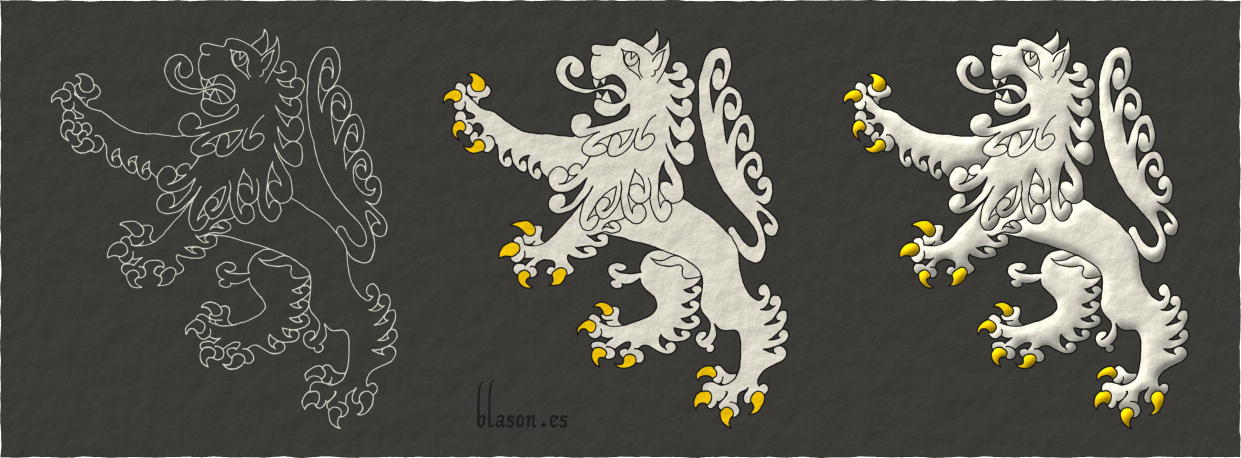
![Axe [ An axe Or ], [ An axe facing sinister Argent, hafted Or ], and [ An axe Argent, hafted Or ].](../escudo_armas/Sketch0337.11.Hacha.Axe.Schema.1x5.FreeHand.jpg)
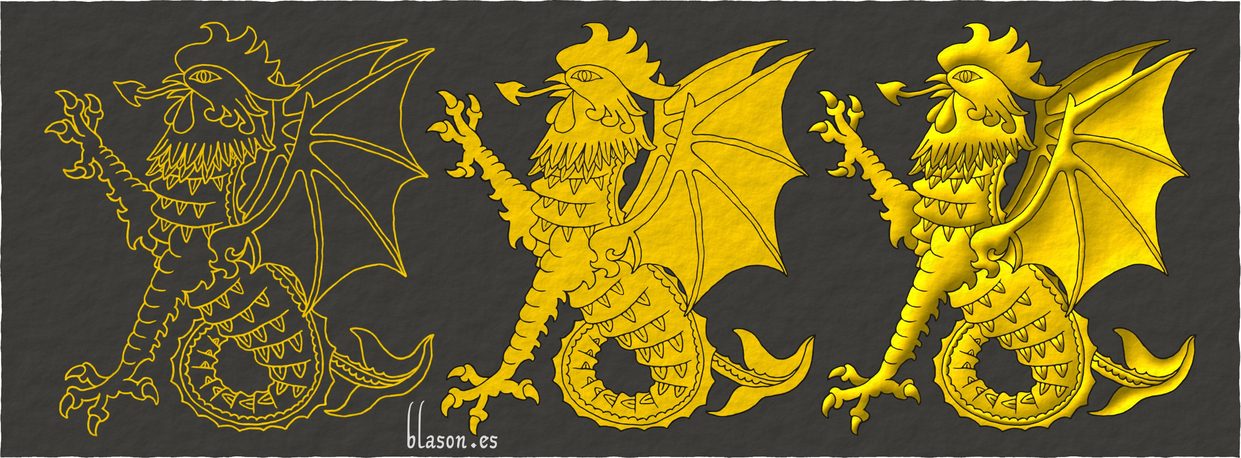


![Ermine [ Ermine ], [ Erminois ] and [ Argent erminois Azure ].](../escudo_armas/Sketch0562.16.Armiños.Armiñado.x2.Ermine.Erminois.Ermined.Schema.1x3.FreeHand.jpg)
